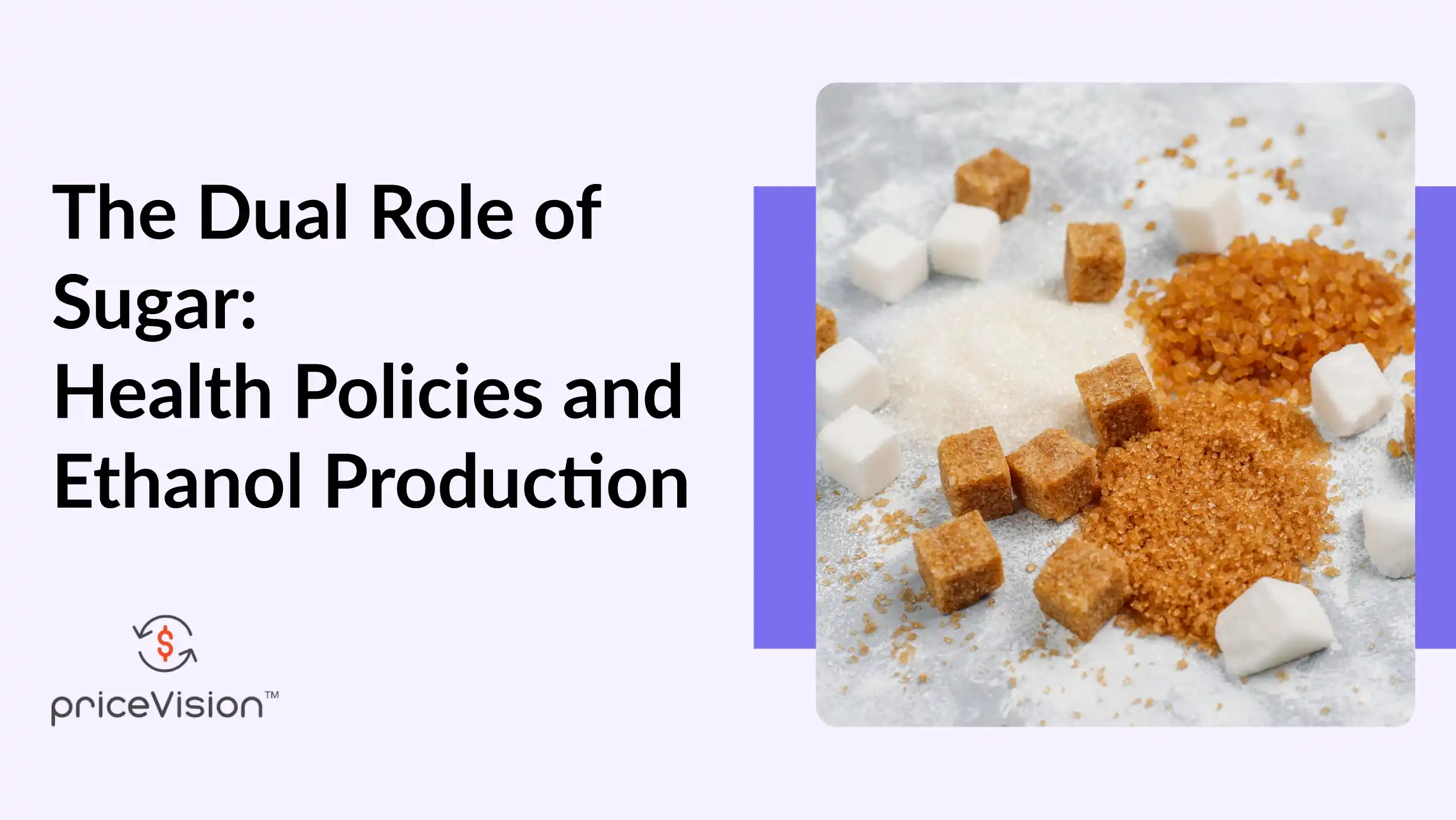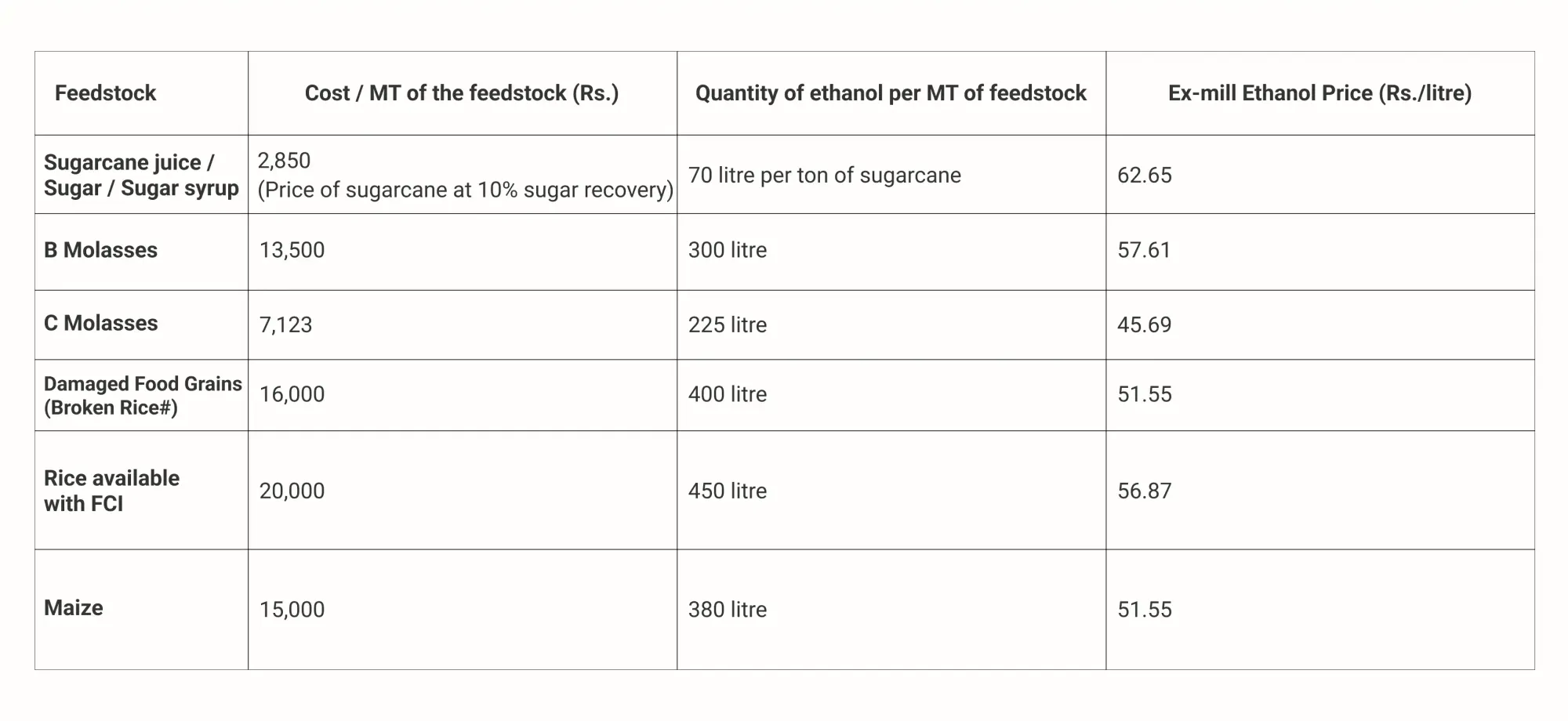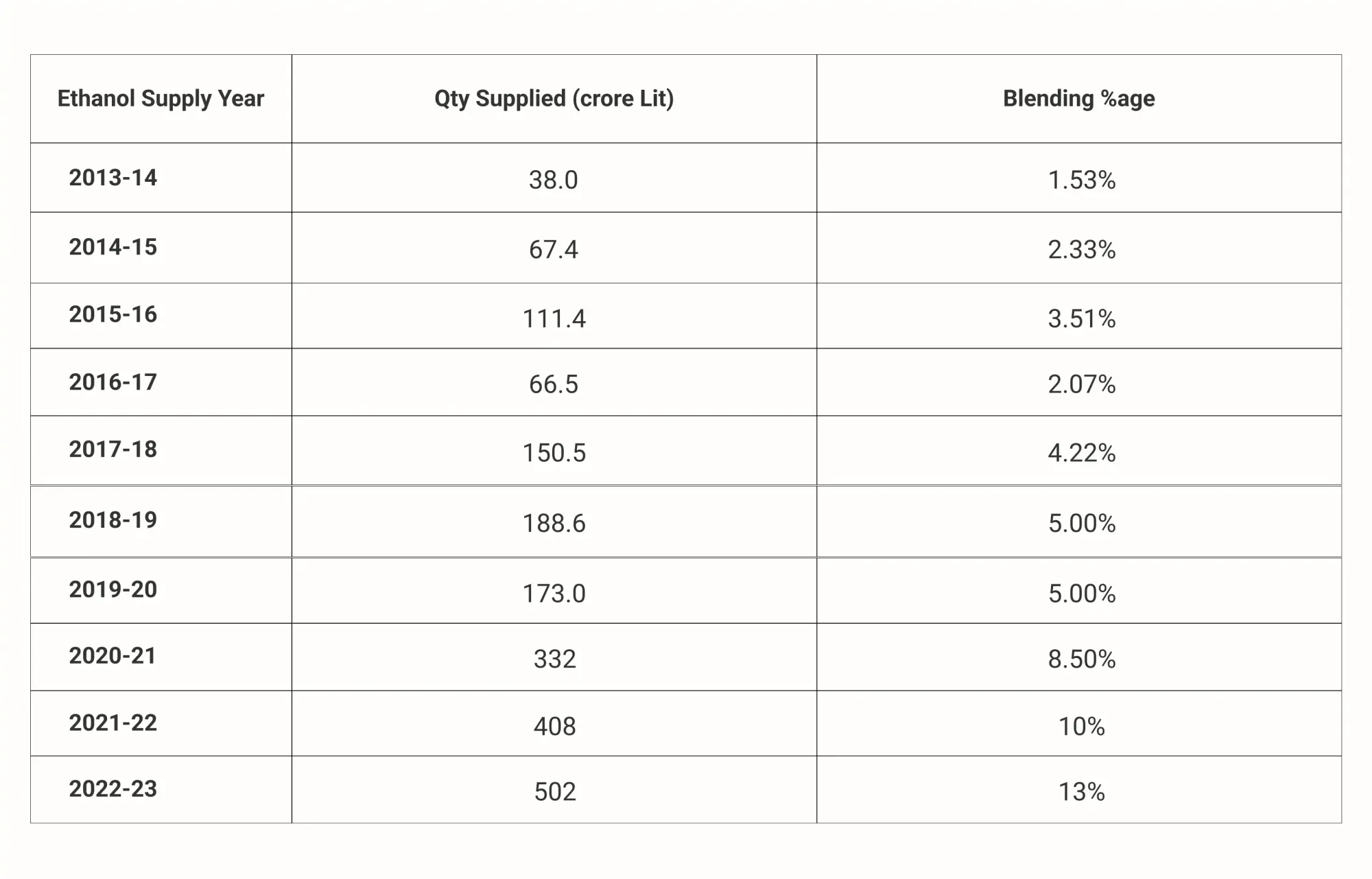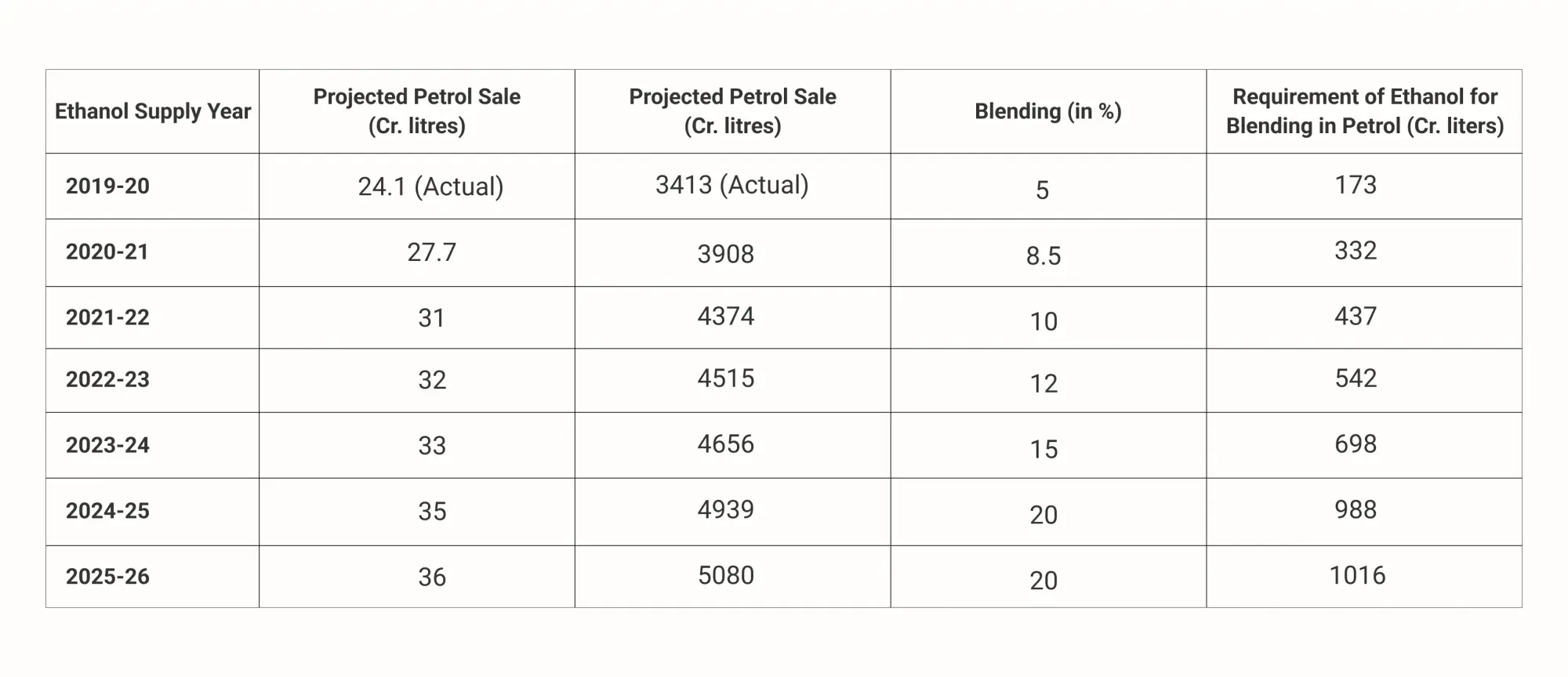The Dual Role of Sugar: Health Policies and Ethanol Production

The worldwide sugar market is going through a period of significant change. Changing health regulations and an increase in the need for ethanol influence this. This complex relationship between health issues and the demand for energy forms a compelling tale of change, creativity, and environmental preservation.
India has made 311 lac tons of sugar as evaluated on 25th April, 2023. In light of the estimated 40 lac tons of sugar equivalent that will be diverted into ethanol, ISMA has updated its estimate of the total amount of sugar produced in India during the 2022–2023 sugar season to 328 lac tons (after diversion into ethanol). (Source)
The industry association ISMA reports that reduced output in Maharashtra was the primary cause of India's 6% decline in sugar production, which came to 311 lakh tonnes as of April 15 of the 2022–2023 marketing year that ended in September. October to September is when sugar is marketed. 328.7 lakh tonnes of sugar were produced during the same time last year.
Production for 2022 - 2023 was expected by ISMA to reach 340 lakh tonnes, up from 358 lakh tonnes in the 2021 - 2022 marketing year. (Source)
To boost domestic supply and maintain steady retail prices, the government has prohibited sugar exports for the current marketing year of 2023–2024, which runs from October to September. About 60 lakh tonnes of sugar were exported by sugar mills last year. By the end of April 2024, the Indian Sugar and Bioenergy Manufacturers' Association (ISMA) said that the amount of sugar produced had reached almost 314 lakh tonnes.
Additionally, they anticipate an increase in sugar production from Tamil Nadu and Karnataka sugar mills of 5–6 lakh tonnes. This indicates that an estimated 320 lakh tonnes of sugar will be produced overall for the 2023–24 marketing year. (Source)
In this blog we're examining the complex identities of the sugar market in this scenario, demonstrating how this age-old commodity sits at the center of contemporary struggles and potential.
Exploring the Sugar Market in India
Occupying the position of the world’s second-largest sugar producer, India is second to Brazil. Uttar Pradesh and Maharashtra are at the forefront in terms of cultivating sugar for the nation. Due to their conducive weather and rich soil, these states play a major role in boosting India's production of sugarcane.
Sugarcane, a type of tropical grass, flourishes under conditions of abundant sunshine and water. The monsoonal climate of India offers the perfect conditions for cultivating sugarcane. It helps in rendering it a lucrative venture for farmers in the right areas. Select cuttings of sugarcane are meticulously planted in well-prepared agricultural fields.
For the ensuing 12 to 18 months, these cuttings mature into tall and robust plants, primed for harvest. The harvesting season in India generally occurs from late October through March, though this can vary based on locality.
Demand for Sweetness: Navigating India's Sugar Market
In India's sugar market, a mix of home consumption, global trades, and official guidelines paints the full picture. The robust demand within the country is primarily fueled by the food and drink industry alongside individual usages.
The sugar industry is pleased with the government's recent decision to permit the export of 60 lakh tons of sugar. This approval aligns with the requests from the Indian Sugar Mills Association (ISMA), advocating for sugar exports under a tradable quota system for the 2022-23 sugar season. The industry expressed gratitude towards the government for implementing a policy that promotes transparency in sugar exports.
Additionally, the government's decision to allow sugar mills to swap their export quotas with the domestic quotas of other mills within 60 days of the order will help in clearing excess stock. This flexibility is expected to help mills generate more revenue and ensure that sugarcane farmers receive their payments on time.
In an earlier press release, the ISMA had asked the government to consider allowing a higher export volume of 90 lakh tons, given the expected total sugar stock in the country. The industry remains hopeful that the government will approve an additional export of 30 lakh tons. Such a move would help maintain stable sugar prices domestically, ensure timely payments to farmers, and reduce the costs associated with high inventory levels at mills.
The forecast for next year's sugar consumption is estimated at 31 million metric tons (MMT), which is equivalent to 29 MMT of crystal white sugar. This represents an increase of nearly 5% over this year's estimate of 29.5 MMT. The rise is expected due to growing demand from bulk buyers and processed food manufacturers. In India, over 30% of sugar is consumed directly by households, while the remainder is used in the production of confectioneries, beverages, and ready-to-eat foods.
For the marketing year 2023/2024, India's sugar exports are expected to increase slightly to 7 million metric tons. This is because the Indian government plans to keep strict export controls in place to avoid any shortages or price changes at home, especially during the election year. Meanwhile, sugar consumption is projected to continue its rise, reaching 31 million metric tons. This increase is supported by the growing demand from India’s ethanol and potable alcohol industries, which use a significant amount of sugarcane and its derivatives. (Source)
Top States in Sugar Production
In 2021, the value of India's sugar market hit $6.148 billion, with projections set to see it grow at a 6.87% compound annual growth rate, reaching $9.791 billion by 2028. (Source)
The sugarcane crushing season in India is currently in full swing, although sugar production is slightly lower compared to the previous season. According to data released by the Indian Sugar & Bio-energy Manufacturers Association (ISMA), as of February 29, 2024, sugar production in the current 2023-24 season reached 25.538 million tons, compared to 25.848 million tons produced by the end of February 2023. This year, 466 factories are operational, an increase from the 447 mills that were operational at the same time last year (February 28, 2023).
Sugar Production State Wise (in lacs tonnes)

The Concern Over Sweetness: Sugar's Role in Health Guidelines
The debate over sugar intake has captured the attention of health policy designers globally. Growing awareness regarding the negative outcomes linked with too much sugar consumption, such as obesity, diabetes type 2, and cardiovascular diseases, has catalyzed changes in public health advisories and shifts in the habits of consumers.
In India, it's estimated that 77 million adults have type 2 diabetes, and nearly 25 million more are considered prediabetic, meaning they are at high risk of developing diabetes soon. Surprisingly, more than half of these individuals are unaware they have the condition, which can lead to serious health complications if it goes undetected and untreated.
In the 2023/2024 period, India consumed 30 million metric tons of sugar, marking a steady increase since the 2019/2020 period, when sugar production was over 28 million metric tons. This trend highlights a growing demand for sugar in the country.
Worldwide Actions Against Sugar Intake
Nations like India have led by example, introducing strategies to cut down on sugar consumption. These tactics range from awareness drives and levies on sugar to mandatory nutritional facts labeling that clues consumers into the sugar levels present in processed edibles and drinks.
● Taxes and Regulations:
Various countries have implemented sugar taxes, imposing extra charges on sweetened beverages and snacks. This method seeks to deter overconsumption by raising the cost of these items.
● Efforts to Raise Public Awareness:
Health bodies and governments are driving initiatives to alert people about the risks associated with excessive sugar consumption. These initiatives typically promote nutritionally sound choices.
● WHO's Recommendations:
The World Health Organization has released a guideline recommending that both grown-ups and kids should reduce their intake of free sugars to less than 10% of their overall daily energy intake for better health. An even more significant benefit would be to lower this consumption to under 5% - roughly 25 grams or around 6 teaspoons per day. (Source)
● Revised Labeling Laws:
New regulations have been put in place demanding clearer and more informative packaging to help shoppers recognize products high in sugar.
Sugar Market's Response to Health Policies
The sugar sector has been significantly affected by these health-oriented policies. It's being pushed towards innovation, by either cutting down on the sugar content in its offerings or finding alternative sweeteners, to cater to the rising demand for healthier alternatives.
India's Transition to Ethanol Production
In recent years, India's decision to start the manufacture of ethanol has sparked a nationwide discussion. This significant move marks a pivotal turn in the country's agricultural and energy policies. It also sets forth a new era of eco-friendliness and sustainability.
In December 2023, the government instructed oil marketing companies (OMCs) to update the amount of sugarcane juice and B heavy molasses allocated to each distillery for ethanol production for the year from November 2023 to October 2024. These companies must then report back to the government with details of the revised contracts.
To support its ethanol blending program, the government has permitted up to 1.7 million tons of sugar to be converted into ethanol, based on the amount that could have been produced from the diverted sugarcane. Ethanol, which is used as a biofuel, is made from molasses—a by-product of sugar production - or directly from sugarcane juice or syrup. (Source)
But why this shift, and what promoted a country traditionally known for its sugar production, to take this bold step? This blog delves into the intricate reasons behind this transition. It will explore the economic, environmental, and social impacts of the switch from sugar to ethanol production.
The Economic Catalysts
The primary reasons behind India's pivot towards ethanol production are deeply rooted in economic challenges and opportunities. For years, the Indian sugar market has been grappling with issues such as overproduction, leading to a significant dip in sugar prices. This surplus not only strained the financial stability of sugar mills but also impacted farmers who struggled with delayed payments.
● Price Volatility of Sugar:
Fluctuating sugar prices have always been a pain point for producers. By diversifying into ethanol, sugar mills can ensure a more stable and predictable revenue stream.
● Government Incentives:
Recognizing the potential of ethanol as an alternative fuel, the Indian government introduced various incentives for ethanol producers, including subsidies and guaranteed pricing, making it a lucrative venture.
● Buffer Against Market Fluctuations:
The move towards ethanol production offers a buffer for the sugar market against market volatility. Ethanol, being in high demand as a biofuel, provides a steady demand enabling sugar mills to plan and budget more efficiently.
● The Environmental Imperative:
Beyond economics, the shift to ethanol production is also driven by environmental considerations. Ethanol, a biofuel, is cleaner and greener compared to fossil fuels, emitting considerably lower levels of harmful pollutants.
● Reduction in Greenhouse Gas Emissions:
The use of ethanol reduces the carbon footprint of vehicles, contributing to efforts against climate change.
● Waste Reduction:
Ethanol production enables the utilization of sugarcane by-products, which would otherwise go to waste, thereby promoting a circular economy.
● Step Towards Sustainable Energy:
By producing ethanol, India is aligning with global efforts to combat climate change. This transition not only decreases reliance on imported oil but also sets a precedent for the adoption of renewable energy sources, highlighting the country's commitment to sustainable development.
● Socio-economic Benefits:
This strategic pivot is not solely about economics or the environment; it carries profound social implications, particularly for the rural economy. Ethanol production promises to invigorate the agricultural sector, offering new avenues for income and employment.
● Boost to Farmers' Income:
With a new market for sugarcane as a raw material for ethanol, farmers can look forward to better earnings and prompt payments.
● Employment Opportunities:
Ethanol production plants require manpower, thus generating employment opportunities in rural areas, which can help curb migration to cities.
The Bitter-Sweet Solution: Ethanol Production
Ethanol production represents a significant opportunity for the sugar market to diversify its applications and reduce dependence on food consumption. This biofuel, produced from the fermentation of sugars, offers a renewable energy source that can help in the battle against climate change.
Ethanol Blending Programme in India
The Ethanol Blending Programme in India is a strategic initiative aimed at enhancing the use of ethanol in the automotive sector, primarily as a means to augment the fuel supply. The program was established to support the agricultural sector, reduce environmental pollution by cutting down on greenhouse gas emissions, and decrease the country's reliance on imported oil.
The drive towards ethanol blending began with pilot projects in 2001, where a 5% ethanol-blended petrol was supplied to retail outlets. The success of these initial trials, along with supportive research and development studies, led the government to formalize the Ethanol Blended Petrol (EBP) Programme in 2003. This program initially mandated the sale of 5% ethanol-blended petrol in nine states and four Union Territories (UTs). (Source)
Over time, the government has extended the mandate, aiming to sell higher ethanol-blended petrol across more states and UTs. This scale-up was influenced by positive experiences and the realization that blending petrol with ethanol could be commercially viable, as per the Bureau of Indian Standards specifications. The program set forth aspirations to incrementally increase the blending percentage.
Ethanol's Growing Importance
Ethanol is increasingly being blended with petrol to reduce carbon emissions and decrease reliance on fossil fuels.
Feedstock cost and Ethanol yield

Countries, including India, have set ambitious targets to increase their ethanol-blend percentages, viewing this as a strategic move towards energy independence and environmental sustainability.
● Energy Security: By producing ethanol locally, countries can decrease their import dependence on oil, fostering greater energy autonomy.
● Environmental Benefits: Ethanol burns cleaner than petrol, emitting fewer greenhouse gases and toxic pollutants. This aligns with global efforts to combat climate change and improve air quality.
● Economic Incentives: For sugar producers, ethanol offers an alternative revenue stream. It enables them to manage oversupply issues more effectively and stabilize incomes in the face of fluctuating global sugar prices.
Ethanol Production
Under the Ethanol Blending Programme (EBP), ethanol supply has grown from 38 crore liters in the Ethanol Supply Year (ESY) 2013-14 to 173 crore liters in ESY 2019-20. This increase has raised the ethanol blend percentage in fuel from 1.53% to 5.00%. Furthermore, the allocated supply for the current ESY 2022-23 has risen to 502 crore liters, marking a substantial increase from the ethanol supply received in the previous ESY. (Source)

(Source 1) (Source 2)(Source 3)
Demand Projection of Fuel Ethanol
The demand for fuel ethanol is projected based on the consumption of petrol (gasoline) and the targeted average ethanol blending rates from the Ethanol Supply Year (ESY) 2020-21 to ESY 2025-26. The following table outlines the ethanol demand projections:

The Path Forward: Finding the Balance
Navigating the dual role of sugar in health policies and ethanol production encapsulates the complexity of modern economic and environmental challenges. The key to success lies in finding a balanced approach that addresses public health concerns, supports sustainable energy goals, and fosters economic growth.
1. Innovating for the Future
The sugar market and policymakers must collaborate closely, leveraging technology and innovation to create healthier products and more efficient ethanol production methods. This includes the development of genetically modified sugar crops that are more sustainable and the exploration of advanced fermentation technologies.
2. Prioritizing Sustainability and Health
Sustainability and public health must remain at the forefront of the sugar market's evolution. This involves making tough decisions, such as reducing sugar content in food and beverages, while also capitalizing on the environmental benefits of ethanol as a biofuel.
3. Strengthening Policies and Partnerships
Strong policies and international partnerships will be essential in steering the sugar market toward a sustainable and health-conscious future. This includes aligning sugar taxation, labeling, and consumption guidelines with global best practices and strengthening collaborations in ethanol production and use.
Conclusion
The sugar market stands at a crossroads, influenced by the dual pressures of health policies and ethanol production. By embracing innovation and sustainability, the industry can navigate these challenges, transforming them into opportunities for growth and positive change. The journey ahead is both sweet and bitter, demanding a nuanced understanding of the market's dynamics and a commitment to the well-being of consumers and the planet. Together, we can chart a course that honors the legacy of sugar while adapting to the demands of the modern world.
FAQs
1. What factors influence the growth of sugarcane in India?
Sugarcane thrives under conditions of abundant sunshine and water, making India's monsoonal climate ideal for its cultivation. Farmers plant cuttings of sugarcane in well-prepared agricultural fields and mature over 12 to 18 months.
2. What drives the demand for sugar in India?
The food and drink industry, individual usage, and the country's food culture, which has a prevalent sweet tooth fuel the demand for sugar in India.
3. How does the Indian government manage the balance between sugar supply and demand?
The government regulates sugar procurement, sets prices, and manages exportation to maintain stable prices, ensure fair earnings for farmers, and manage stockpiles.